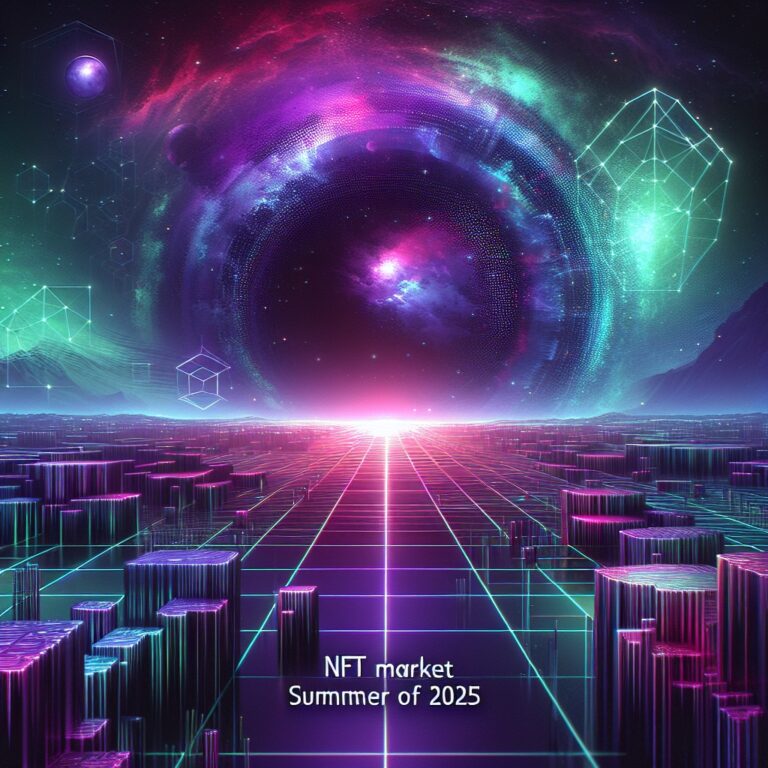In the summer of 2025, as the NFT market grapples with its own identity crisis, the mantra “I’d love it even if it went to zero” still resonates with a select group of collectors who see beyond the volatile price tags. This phrase, once a tongue-in-cheek declaration during the NFT boom of 2021, captures a sentiment that transcends mere monetary gain—it’s about belonging to a subculture that values meaning over money. Yet, as the NFT market stumbles amidst a chilling Crypto Winter, the allure of such digital artifacts is being tested like never before.
The Grizzly Market
July 2025 has seen the NFT trading volume nosedive to $156 million, a stark contrast to the heady days of August 2021 when OpenSea boasted over $3 billion in trades. While a few high-profile transactions, like the recent sale of 45 CryptoPunks for nearly $8 million, offer glimmers of hope, the overall market struggles. NFT art, in particular, is down a staggering 93% from its peak, leaving many to question the intrinsic value of these once-coveted digital assets. This mirrors broader trends in the crypto market, as highlighted in our report on how crypto spot trading is down 22% in Q2, despite a Bitcoin rally.
“Are NFTs merely overpriced JPEGs or cultural relics with staying power?” This question echoes in the minds of many investors, including those holding pieces like Bert is Evil. Minted in November 2022 by its original creator, this NFT represents one of the internet’s earliest viral memes, yet it languishes in obscurity, seemingly worth zero.
The Story of Bert
Bert is Evil, a meme from the internet’s nascent days, depicted the Sesame Street character in a series of controversial and humorous scenarios. Created by Dino Ignacio in 1997, the meme became a cultural phenomenon, spreading through nascent online forums and email chains. However, when an altered image of Bert appeared at a pro-Taliban rally in 2001, Ignacio shut down the website, believing the joke had gone too far.
Fast forward to the Web3 era, and Ignacio’s attempt to immortalize Bert as an NFT met with tepid interest. “Maybe I just don’t understand NFTs,” he confessed, reflecting a sentiment shared by many creators attempting to bridge Web1 and Web3 cultures without the requisite Web3 street cred.
Immutable Culture
What’s fascinating is how the Bert NFT speaks to the broader cultural dynamics of Web3. Despite its commercial flop, Bert is Evil offers a poignant case study in media continuity and cultural preservation. “The medium is the message,” as media theorist Marshall McLuhan would say. Unlike a simple JPEG, the NFT format transforms the viewer into a participant, a stakeholder in a digital narrative that extends beyond visual aesthetics.
Ignacio’s NFT project underscores the challenges faced by creators entering the blockchain domain. Web3’s tribal culture often demands a level of engagement and credibility that can be daunting for outsiders. “It’s a clique with its own meeting places, rituals, and language,” observes one analyst. Ignacio’s impressive Web2 pedigree failed to translate into Web3 validation, illustrating the community’s insular nature.
A Surprising Twist
In a surprise turn of events, the Bureau of Internet Culture (BIC) recently acquired the second Bert NFT, recognizing it as a piece of immutable meme history. This purchase, by a collective known for its vast meme treasury, brings newfound attention to Bert is Evil and validates its cultural significance.
For Ignacio, this development is bittersweet. The NFT’s newfound recognition highlights the importance of external validation in establishing value, yet it arrives after a tumultuous journey marked by scams and self-doubt. “Belief in value needs to be validated,” muses a crypto analyst, pointing to the role of cultural narrative and community support in driving NFT worth. This sentiment echoes the broader market dynamics, as explored in our article on what crypto derivatives say about Bitcoin’s record price.
Reflection and Future Outlook
As the NFT market continues to evolve, the story of Bert is Evil serves as a reminder of the complex interplay between culture, technology, and value. For those who still cherish their digital collectibles despite financial losses, the question remains: Do you love it for what it is, or for what it represents? The answer may well shape the future of NFTs as cultural artifacts.
Looking ahead, the NFT community faces an ongoing challenge: bridging the gap between technological innovation and cultural acceptance. Whether this will lead to a renaissance or further decline remains an open question, but one thing is certain: the conversation around NFTs is far from over.
Source
This article is based on: Still Loving My ‘If It Went to Zero’ NFT
Further Reading
Deepen your understanding with these related articles:
- $150 Billion Wiped Out From Crypto Markets as Bitcoin Drops Below $117K: Market Watch
- Crypto Market Is in The Early Stages of Altcoin Season, Analysts Suggest
- Crypto Markets Bifurcate With Institutions Focusing on BTC and ETH While Retail Chases Alts: Wintermute

Steve Gregory is a lawyer in the United States who specializes in licensing for cryptocurrency companies and products. Steve began his career as an attorney in 2015 but made the switch to working in cryptocurrency full time shortly after joining the original team at Gemini Trust Company, an early cryptocurrency exchange based in New York City. Steve then joined CEX.io and was able to launch their regulated US-based cryptocurrency. Steve then went on to become the CEO at currency.com when he ran for four years and was able to lead currency.com to being fully acquired in 2025.


